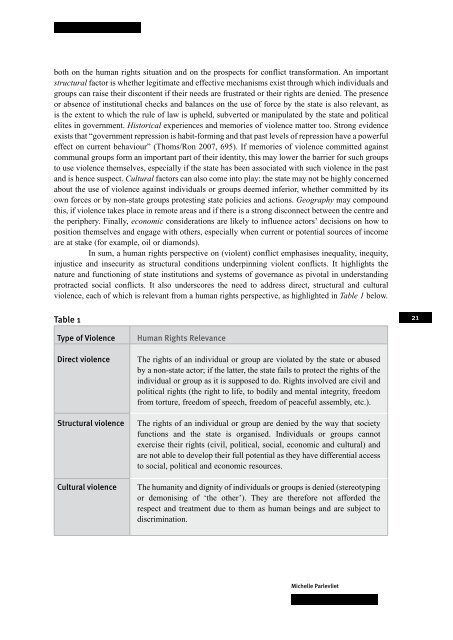Human rights and conflict transformation: The challenges of just peace
Human rights and conflict transformation: The challenges of just peace
Human rights and conflict transformation: The challenges of just peace
Create successful ePaper yourself
Turn your PDF publications into a flip-book with our unique Google optimized e-Paper software.
oth on the human <strong>rights</strong> situation <strong>and</strong> on the prospects for <strong>conflict</strong> <strong>transformation</strong>. An important<br />
structural factor is whether legitimate <strong>and</strong> effective mechanisms exist through which individuals <strong>and</strong><br />
groups can raise their discontent if their needs are frustrated or their <strong>rights</strong> are denied. <strong>The</strong> presence<br />
or absence <strong>of</strong> institutional checks <strong>and</strong> balances on the use <strong>of</strong> force by the state is also relevant, as<br />
is the extent to which the rule <strong>of</strong> law is upheld, subverted or manipulated by the state <strong>and</strong> political<br />
elites in government. Historical experiences <strong>and</strong> memories <strong>of</strong> violence matter too. Strong evidence<br />
exists that “government repression is habit-forming <strong>and</strong> that past levels <strong>of</strong> repression have a powerful<br />
effect on current behaviour” (Thoms/Ron 2007, 695). If memories <strong>of</strong> violence committed against<br />
communal groups form an important part <strong>of</strong> their identity, this may lower the barrier for such groups<br />
to use violence themselves, especially if the state has been associated with such violence in the past<br />
<strong>and</strong> is hence suspect. Cultural factors can also come into play: the state may not be highly concerned<br />
about the use <strong>of</strong> violence against individuals or groups deemed inferior, whether committed by its<br />
own forces or by non-state groups protesting state policies <strong>and</strong> actions. Geography may compound<br />
this, if violence takes place in remote areas <strong>and</strong> if there is a strong disconnect between the centre <strong>and</strong><br />
the periphery. Finally, economic considerations are likely to influence actors’ decisions on how to<br />
position themselves <strong>and</strong> engage with others, especially when current or potential sources <strong>of</strong> income<br />
are at stake (for example, oil or diamonds).<br />
In sum, a human <strong>rights</strong> perspective on (violent) <strong>conflict</strong> emphasises inequality, inequity,<br />
in<strong>just</strong>ice <strong>and</strong> insecurity as structural conditions underpinning violent <strong>conflict</strong>s. It highlights the<br />
nature <strong>and</strong> functioning <strong>of</strong> state institutions <strong>and</strong> systems <strong>of</strong> governance as pivotal in underst<strong>and</strong>ing<br />
protracted social <strong>conflict</strong>s. It also underscores the need to address direct, structural <strong>and</strong> cultural<br />
violence, each <strong>of</strong> which is relevant from a human <strong>rights</strong> perspective, as highlighted in Table 1 below.<br />
Table 1<br />
Type <strong>of</strong> Violence <strong>Human</strong> Rights Relevance<br />
Direct violence <strong>The</strong> <strong>rights</strong> <strong>of</strong> an individual or group are violated by the state or abused<br />
by a non-state actor; if the latter, the state fails to protect the <strong>rights</strong> <strong>of</strong> the<br />
individual or group as it is supposed to do. Rights involved are civil <strong>and</strong><br />
political <strong>rights</strong> (the right to life, to bodily <strong>and</strong> mental integrity, freedom<br />
from torture, freedom <strong>of</strong> speech, freedom <strong>of</strong> <strong>peace</strong>ful assembly, etc.).<br />
Structural violence <strong>The</strong> <strong>rights</strong> <strong>of</strong> an individual or group are denied by the way that society<br />
functions <strong>and</strong> the state is organised. Individuals or groups cannot<br />
exercise their <strong>rights</strong> (civil, political, social, economic <strong>and</strong> cultural) <strong>and</strong><br />
are not able to develop their full potential as they have differential access<br />
to social, political <strong>and</strong> economic resources.<br />
Cultural violence <strong>The</strong> humanity <strong>and</strong> dignity <strong>of</strong> individuals or groups is denied (stereotyping<br />
or demonising <strong>of</strong> ‘the other’). <strong>The</strong>y are therefore not afforded the<br />
respect <strong>and</strong> treatment due to them as human beings <strong>and</strong> are subject to<br />
discrimination.<br />
Michelle Parlevliet<br />
21

















